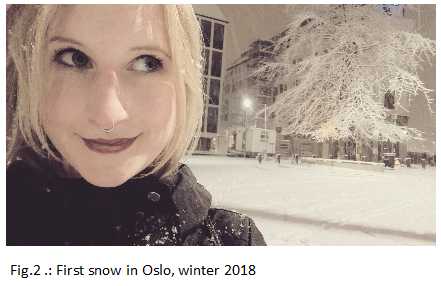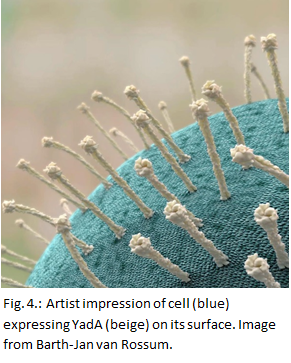Read this blog in:
Deciphering Bacterial Adhesion to Host Cells in Oslo
“Life is sort of a circle. You come back to a lot of the interests you had early in life.”
[Eric Kandel, Nobel prize winner]
How it all started
My name is Ina and I am the PhD student working on bacterial adhesion to host cell surfaces in the group of Dirk Linke in Oslo, Norway. Originally I am from a little town in Germany close to the D utch border, but I spend quite some time studying biochemistry in Tuebingen, Germany.
utch border, but I spend quite some time studying biochemistry in Tuebingen, Germany. 
This is where I fell in love with bacterial membrane proteins during my bachelor studies.
Tuebingen is also the place where the circle “started”.
I stumbled upon an advertisement of a group at the Max Planck Institute searching for a student working on bacterial outer membrane proteins. Funnily, this was the group of Dirk Linke, which was at that time, years ago, still working at the MPI. I applied and got the position. After my bachelors I had fallen for membrane protein work and decided to stick with bacterial proteins also during my masters. I therefore joined one of the leading groups in bacterial outer membrane protein biogenesis at Harvard as part of my master programme in Tuebingen (Fig.1). Afterwards, I did my thesis on outer membrane proteins in one of the most resistant bacterial species known so far (Acinetobacter baumannii). After that I worked at the Max Planck Institute for almost a year until I started my position as a ViBrANT PhD in the group of Dirk Linke which had moved to Oslo in the meantime (Fig. 2).
You see, here is where the perfect circle closes and I am really happy about it. So my new life hast started now and as you can see I enjoy it quite a lot (though I spend more time in the laboratory than at the harbour…) (Fig. 3).

Why are we doing this?
So, now let’s talk science as bit. Why is my project important and what exactly do I do? To say it quite simply; I look at how certain types of bacteria bind to our cells (host cells). So far w e do not know how exactly binding works on a molecular level. Additionally, many bacteria employ proteins that bind to a variety of host cell structures. Our goal is to find out what the differences in binding are and whether we can stop the bacteria from binding to our cells. The bacteria-host interaction is especially important early on in an infection.
e do not know how exactly binding works on a molecular level. Additionally, many bacteria employ proteins that bind to a variety of host cell structures. Our goal is to find out what the differences in binding are and whether we can stop the bacteria from binding to our cells. The bacteria-host interaction is especially important early on in an infection.
The pathogen I work with is Yersinia and its adhesive protein called Yersinia adhesin A (YadA) (Fig. 4). This bacterium causes a foodborne disease called Yersiniosis. If infected with Yersinia, patients usually get diarrhea. Unfortunately, since Yersinia can also infect underlying tissues, the bacterium can also cause arthritis or even septicemia. We therefore want to know more about how the bacterium sticks to host cells and initiates infections. With this we hope to get a better understanding of interactions of bacteria and their hosts.
In order to see these differences in binding, we will employ a technique called nuclear magnetic resonance and maybe also crystallography to be able to see molecular changes in the protein during binding events. If we can find out how exactly binding works we can use this to tackle initiation of infections and maybe prevent infections.



